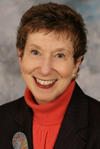The Harvard Family Research Project separated from the Harvard Graduate School of Education to become the Global Family Research Project as of January 1, 2017. It is no longer affiliated with Harvard University.

|
April 24, 2014 Lessons From Museums and Libraries: Five Ways to Address Families’ Digital Learning NeedsMarsha L. Semmel
|
FINE Newsletter, Volume VI, Issue 2
Issue Topic: Making it Real—Connected Learning in the Digital Age
Tips & Tools
Marsha L. Semmel discusses five ways that libraries and museums play important roles in addressing our children’s digital learning needs.
In this time of dynamic, technologically fueled societal change, museums and libraries are ramping up their offerings for parents and families in support of such vital 21st-century learning skills as problem solving, collaboration, digital media literacy, and creativity. Here are five ways that libraries and museums play important roles in addressing our children’s digital learning needs.

 |
Trusted Places. As community anchors, libraries and museums have long served as welcoming and safe environments for cross-generational learning. For many parents, these sites are less threatening, more familiar, and more accessible than the local school. Many museums and libraries have developed family-focused activities that tap into the power of new media. They are creating lounges, interactive exhibitions, and “maker” and play spaces, where families can experiment, create, learn, relax, and have fun together. These programs and environments often combine digital and nondigital components, and many offer parents specific insights about safe, age-appropriate digital media use. |
 |
Access. The digital divide is a reality for many families, with far too many still unable to access the Internet from home. Even among households with a computer, family members often compete for screen and homework time, or lack basic digital literacy instruction. Libraries provide free public-access computers, often located in special family-oriented areas. Additionally, museum and library websites increasingly offer virtual pre- and postvisit guidance, participatory learning challenges, and parental tips. And with the explosion in the use of mobile devices, many museums and libraries have developed free and easily downloadable “apps” geared to family audiences. The American Museum of Natural History, for example, offers the Beyond Planet Earth App, which is a companion to the museum’s Beyond Planet Earth exhibit, and allows families to access supplemental content and animations, both at the museum and at home. |
 |
Resources. Libraries and museums have been ramping up their online holdings, experiences (on-site and online), and services, increasingly customized to the needs and interests of digitally curious and digitally savvy families. These institutions often align digitized history, culture, arts, and science collections and programs with school standards, Common Core requirements, and age-appropriate at-home activities. Some libraries and museums teach youth the fundamentals of computer programming and video games, in concert with Internet safety, privacy, and online etiquette. Many libraries make e-books the focus of family story times, modeling recommended parent–child digital media interaction. |
 |
Expertise. The roles of museum and library staff and volunteers in facilitating effective learning experiences continue to evolve in response to the changing needs and expectations of users. Librarians are now “digital navigators” who support mastery of online skills and suggest useful and trustworthy digital resources. The Children’s Museum of Houston has created 21-Tech: Engaging Visitors Through Mobile Technology, a virtual resource used nationally that trains museum staff to “curate” trustworthy, STEM-relevant, tablet-based “apps” that enable families to continue their learning experiences after the museum visit. The librarians and mentors at Chicago Public Library’s drop-in YOUmedia space, and other youth-focused learning labs in museums and libraries around the country, support teens’ peer-to-peer learning in digital production and performance. |
 |
Community Learning Partnerships. Increasingly, museums and libraries are coordinating efforts with civic officials, parents, schools, and social service organizations to virtually map and align out-of-school learning opportunities across the community, including those focusing on digital use and production. These partners are making previously uncharted learning pathways (from early childhood through adolescence or from novice to expert) clearly visible and accessible to youth and families. The Chicago City of Learning initiative, for example, is creating a citywide digital badging system that not only identifies and tracks these pathways, but also provides appropriate “credit” for youth participation. |
|
Programs in Action
The programs below are great examples of how libraries and museums are partnering with educators and families to promote 21st-century learning.
A Blueprint: Maker Programs for Youth (New York Hall of Science, 2013) STAR_Net (Science-Technology Activities & Resources for Libraries) HowtoSMILE.org: All the Best Science & Math Activities |
|
The Evaluation Lens
Evaluation plays a key role in helping libraries and museums develop sustainable and scalable programs. The Center for Advancement of Informal Science Education (CAISE) works in collaboration with the NSF Informal Science Education Program (ISE) to strengthen and advance the field of informal science education and its infrastructure by providing resources for NSF principal investigators, ISE professionals, and STEM researchers. Visit the CAISE database to access hundreds of program evaluations that cover a range of topics, including STEM and digital media and learning. Another useful source for stories, research, and evaluation on youth learning in the digital age is www.connectedlearning.tv. |
Marsha L. Semmel is an independent consultant on leadership, partnerships, and policy for cultural institutions. She is also a senior advisor to the Noyce Leadership Institute, an initiative of the Noyce Foundation, which works with a global network of executives in science centers, children’s museums, and other cultural organizations to strengthen the boldness of these individuals’ (and their organizations’) community-engagement strategies, depth of partnerships, and responses to future trends. Prior to joining the Noyce Foundation, she was the director for strategic partnerships at the Institute of Museum and Library Services from 2003–13.
This resource is part of the April FINE Newsletter. The FINE Newsletter shares the newest and best family engagement research and resources from Harvard Family Research Project and other field leaders. To access the archives of past issues, please visit www.hfrp.org/FINENewsletter.
